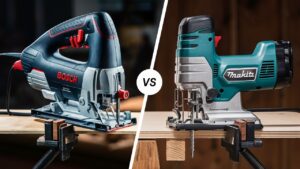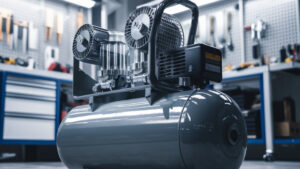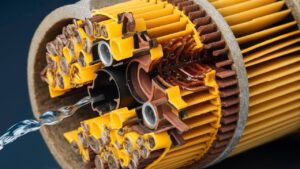Drilling through steel beams requires special drill bits. Not all bits can handle the toughness of steel.
Understanding the right features of drill bits for steel beams is key. It ensures efficiency and safety in your project. From material to design, each feature plays a role. Some bits offer more strength, while others focus on precision. Knowing what to look for can make a big difference.
This guide will help you understand the essential features. It will also show how these features affect performance. By the end, you’ll know which drill bits are best for steel beams. Let’s dive into the details and make your drilling tasks easier and more effective.
Introduction To Drill Bits For Steel Beams
Drilling through steel beams requires specialized tools. The right drill bit can make the job easier and more efficient. In this post, we will explore the features of drill bits specifically designed for steel beams.
Importance Of Proper Drill Bits
Using the correct drill bit is crucial. It ensures precision and reduces wear and tear on the tool. Steel beams are tough. They require drill bits that can withstand high pressure and heat.
Here are some key factors to consider:
- Material: High-speed steel (HSS) and cobalt are ideal.
- Coating: Titanium or black oxide coatings enhance durability.
- Point Angle: A 135-degree split point is effective.
- Shank Type: Choose between straight or reduced shank.
Overview Of Steel Beams
Steel beams are structural elements. They support buildings and bridges. Their composition makes them strong and durable.
Types of steel beams include:
- I-Beams: Also known as H-beams, they have a horizontal flange.
- W-Beams: They are wide-flange beams with parallel flanges.
- Channel Beams: These have a C-shaped cross-section.
Understanding the type of steel beam helps in selecting the right drill bit. This ensures efficiency and accuracy in your work.

Types Of Drill Bits
Drilling through steel beams requires specialized drill bits designed for tough materials. Understanding the types of drill bits is essential for efficient and effective drilling. Below, we explore the various types of drill bits suitable for steel beams.
Twist Drill Bits
Twist drill bits are the most common type of drill bits. They are versatile and can be used for a variety of materials. These bits have a spiral design that helps remove debris from the hole.
- Material: Typically made from high-speed steel (HSS).
- Design: Spiral flutes that provide good chip ejection.
- Use: Suitable for general-purpose drilling, including steel.
Cobalt Drill Bits
Cobalt drill bits are made from a special alloy containing 5-8% cobalt. This makes them more durable and resistant to heat.
- Material: High-speed steel with cobalt alloy.
- Design: Similar to twist bits but more robust.
- Use: Ideal for drilling through harder metals like stainless steel.
Carbide-tipped Drill Bits
Carbide-tipped drill bits are known for their exceptional hardness and longevity. These bits can handle the toughest drilling tasks.
- Material: Steel body with carbide tips.
- Design: Tipped with carbide for superior cutting edge.
- Use: Best for high-strength steel and other tough materials.
| Type | Material | Best Use |
|---|---|---|
| Twist Drill Bits | High-speed steel | General-purpose drilling |
| Cobalt Drill Bits | Cobalt alloy | Hard metals like stainless steel |
| Carbide-Tipped Drill Bits | Steel with carbide tips | High-strength steel |
Material Composition
Understanding the material composition of drill bits for steel beams is crucial. The right material ensures efficiency, durability, and precision. Different materials are used to create drill bits, each with unique properties. Below, we explore the main types of materials used in drill bits.
High-speed Steel (hss)
High-Speed Steel, or HSS, is a popular choice for drill bits. It offers excellent cutting capabilities. HSS is known for its durability and resistance to heat. This makes it ideal for drilling through steel beams. It retains its hardness at high temperatures, ensuring long-lasting performance.
Cobalt Alloys
Cobalt alloys are another option for drilling through steel. These drill bits contain a mix of cobalt and steel. The added cobalt increases the bit’s hardness and heat resistance. This makes them perfect for tougher jobs. Cobalt drill bits last longer and perform better under stress.
Solid Carbide
Solid carbide drill bits are the most durable option. They are made from a combination of carbon and tungsten. These bits are extremely hard and can withstand high temperatures. They are ideal for professional use. Solid carbide bits maintain sharpness for a long time, providing precise cuts.
Coatings And Treatments
Choosing the right drill bits for steel beams involves understanding their coatings and treatments. These coatings and treatments enhance the drill bit’s performance, durability, and efficiency. Here, we will dive into three popular coatings and treatments: Titanium Nitride Coating, Black Oxide Coating, and Cryogenic Treatment.
Titanium Nitride Coating
Titanium Nitride (TiN) coating is a gold-colored layer applied to drill bits. This coating improves the bit’s hardness and heat resistance. TiN-coated drill bits last longer and perform better in high-temperature applications. They also reduce friction, which helps in smoother drilling and extends the bit’s life.
The TiN coating makes the drill bits perfect for drilling through tough materials like steel beams. The reduced friction results in less wear and tear on the bit. This means fewer replacements and more cost savings over time.
Black Oxide Coating
Black Oxide coating is another popular treatment for drill bits. This coating gives the bits a black finish and enhances their durability. It helps to reduce the friction between the bit and the material, making drilling more efficient.
The Black Oxide coating also provides corrosion resistance, which is crucial for extending the life of the drill bits. It’s particularly useful when drilling in humid or wet conditions. This makes Black Oxide coated bits ideal for various environments and steel beam projects.
Cryogenic Treatment
Cryogenic treatment involves freezing the drill bits at extremely low temperatures. This process changes the metal’s structure, making it more durable and less prone to wear. Cryogenically treated bits can handle the stress of drilling through steel beams more effectively.
The treatment also improves the toughness of the drill bits, reducing the chances of breaking under pressure. This makes them reliable for heavy-duty drilling tasks. Cryogenic treatment is an excellent choice for professionals needing high-performance and long-lasting drill bits.
Bit Design And Geometry
Choosing the right drill bit for steel beams is essential. The bit design and geometry play a crucial role. They determine the efficiency and accuracy of the drilling process. Understanding these features can help you make an informed decision.
Point Angle
The point angle of a drill bit affects its cutting ability. A 118-degree point angle is common for drilling steel. It provides a good balance of sharpness and durability. For harder steels, a 135-degree point angle is better. It reduces walking and ensures a precise start.
Flute Design
Flute design is crucial for chip removal. Straight flutes are common and provide good chip removal. Spiral flutes are also popular. They help in removing chips more efficiently. This prevents clogging and improves drilling speed.
Shank Types
Shank types vary based on the drill bit. Straight shanks are most common. They fit standard drill chucks. Reduced shanks are useful for larger bits. They allow use with smaller chucks. Hex shanks offer better grip and prevent slipping.
Performance And Durability
Drill bits for steel beams must be highly performant and durable. Performance and durability are critical features, ensuring efficient and long-lasting drilling. Let’s explore these aspects in detail.
Heat Resistance
Drilling through steel generates a lot of heat. High-quality drill bits have heat resistance to withstand this. Heat-resistant materials, like cobalt and carbide, prevent the bit from dulling. This maintains the sharpness of the cutting edge.
Heat resistance also extends the lifespan of the drill bit. This means fewer replacements and more cost savings. Look for drill bits specifically designed for high-temperature applications.
Wear Resistance
Drill bits must endure constant wear and tear. Wear resistance is crucial for longevity. Hardened steel, coated with titanium or black oxide, offers excellent wear resistance. These coatings protect the bit from surface damage and corrosion.
Enhanced wear resistance leads to consistent performance. It also reduces the frequency of sharpening. Choose drill bits with robust wear-resistant properties for heavy-duty tasks.
Cutting Efficiency
Effective drilling requires high cutting efficiency. This means the bit cuts through steel quickly and smoothly. Sharp cutting edges and precision-ground tips ensure efficient material removal. This reduces friction and heat buildup.
Drill bits with high cutting efficiency save time and effort. They produce cleaner holes and reduce the risk of bit breakage. Opt for bits with advanced geometries and cutting-edge designs for optimal results.
Proper Usage Techniques
Using drill bits for steel beams requires specific techniques. These methods ensure efficiency and safety. Proper usage also extends the life of the drill bit.
Drilling Speed And Feed Rate
Controlling the drilling speed and feed rate is crucial. High speed can cause overheating. This damages the bit and the steel beam. Use a slow speed setting. Increase the feed rate gradually. This ensures a smooth drilling process.
Here is a simple table to understand the recommended speeds:
| Drill Bit Size | Recommended RPM |
|---|---|
| 1/8 inch | 2,500 RPM |
| 1/4 inch | 1,200 RPM |
| 1/2 inch | 600 RPM |
Lubrication And Cooling
Always use lubrication and cooling when drilling steel beams. This reduces friction. It also prevents the drill bit from overheating. Apply cutting oil or a water-based coolant. This will keep the drill bit cool.
Here are a few types of lubricants you can use:
- Cutting Oil
- Water-based Coolant
- Paste Lubricants
Pilot Holes
Creating pilot holes is a good practice. It guides the main drill bit. This reduces the risk of the bit slipping. Use a smaller drill bit to make a pilot hole first. Then, use the main bit to enlarge the hole.
Steps for drilling pilot holes:
- Mark the drilling spot.
- Use a center punch to create an indent.
- Drill a small pilot hole using a smaller bit.
- Switch to the main drill bit and enlarge the hole.
Following these steps ensures precision and accuracy. It also reduces wear on your drill bits.
Maintenance And Care
Maintaining and caring for your drill bits ensures they last longer and perform better. Proper upkeep prevents wear and tear, saving you money and time in the long run. Below are essential tips for cleaning, storing, sharpening, and safely using your drill bits for steel beams.
Cleaning And Storage
Regular cleaning of drill bits is crucial. After each use, wipe off any metal shavings. Use a brush to remove stubborn particles. Avoid using water, as it can cause rust. Instead, use a cloth with a bit of machine oil.
Store your drill bits in a dry place. Use a drill bit case or holder. This keeps them organized and protected from damage. Avoid throwing them into a toolbox where they can get nicked or bent.
Sharpening Techniques
Sharp drill bits cut through steel beams more efficiently. Use a bench grinder for sharpening. Hold the bit at the correct angle. Rotate it to ensure an even edge.
For precise sharpening, use a drill bit sharpening tool. It provides the right angle and depth. Follow the manufacturer’s instructions for best results.
After sharpening, check the bit for any cracks or damage. Replace any bits that show signs of wear.
Safety Tips
Always wear protective gear when handling drill bits. Gloves protect your hands from sharp edges. Safety glasses shield your eyes from flying debris.
Ensure the drill bit is securely fastened in the drill. Loose bits can cause accidents. Check the drill’s speed settings. Use the correct speed for drilling steel beams.
Keep your work area clean and well-lit. This reduces the risk of accidents and improves precision. Always follow safety guidelines provided by the drill and bit manufacturers.
Choosing The Right Drill Bit
Choosing the right drill bit for steel beams is crucial for any project. The correct bit can save time and ensure precise results. This section will guide you through the key factors to consider.
Project Requirements
First, think about the scope of your project. Are you working on a small home improvement task? Or a large-scale construction project? Small projects may only need basic drill bits. Large projects might require specialized bits for precision and durability.
Consider the type of steel you are drilling. Different steel types may need different drill bits. High-speed steel (HSS) bits are common. But cobalt or carbide-tipped bits are better for harder steel.
Budget Considerations
Budget is another important factor. High-quality drill bits often cost more. But they last longer and perform better. Cheap bits may seem like a good deal. But they wear out quickly and can break.
Investing in a good set of drill bits can save money in the long run. Think about how often you will use them. If you drill steel beams regularly, investing in high-quality bits is wise.
Brand Comparisons
Not all drill bits are created equal. Some brands have better reputations for quality. Research and compare different brands. Read reviews and ask for recommendations.
Popular brands include DeWalt, Bosch, and Irwin. Each brand has its strengths. DeWalt is known for durability. Bosch offers precision. Irwin provides good value for money.
Frequently Asked Questions
What Are The Key Features Of Drill Bits For Steel Beams?
Drill bits for steel beams are made from high-speed steel or cobalt. They have a robust design, heat resistance, and sharp cutting edges. These features ensure efficient drilling, durability, and precision.
Why Is Heat Resistance Important In Drill Bits?
Heat resistance prevents the drill bits from getting damaged during use. It ensures the drill bit remains sharp and effective, even with prolonged use. This feature is crucial for drilling into tough materials like steel beams.
How Does A Cobalt Drill Bit Benefit Steel Beam Drilling?
Cobalt drill bits are more durable and heat-resistant than standard bits. They maintain their sharpness for longer periods. This makes them ideal for drilling through hard materials like steel beams, providing clean and precise holes.
Are There Specific Sizes Of Drill Bits For Steel Beams?
Yes, drill bits for steel beams come in various sizes. The size depends on the required hole diameter. Choosing the correct size ensures efficient drilling and prevents damage to the bit and material.
Conclusion
Steel beams require precise drilling. Choosing the right drill bit is crucial. Quality bits ensure clean holes. Durability matters for long-term use. Speed and efficiency save time. Consider bit material and coating. Proper size fits your project needs. Sharpness impacts performance.
Invest in reliable brands. Enhanced features make tasks easier. Always prioritize safety. Select wisely for best results.








